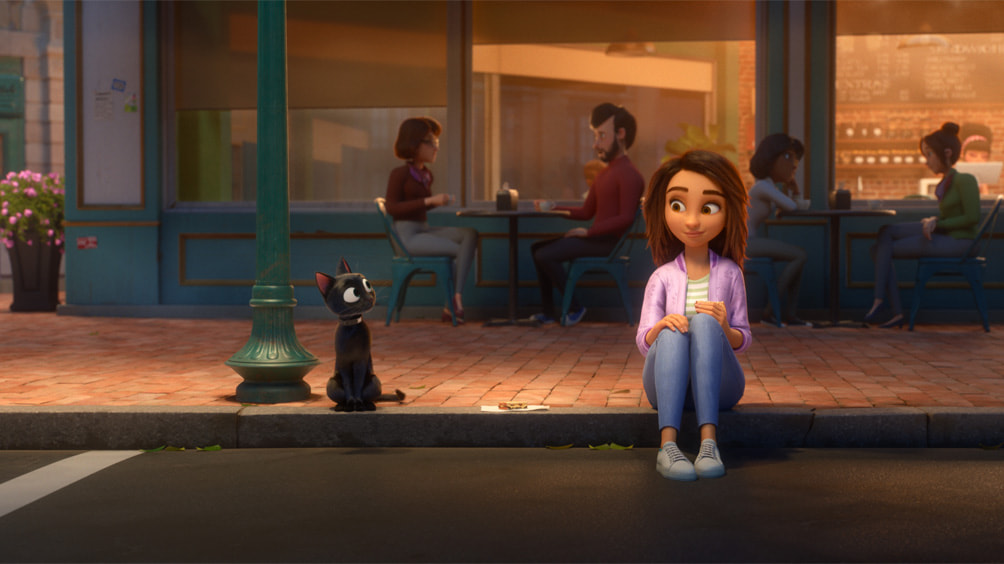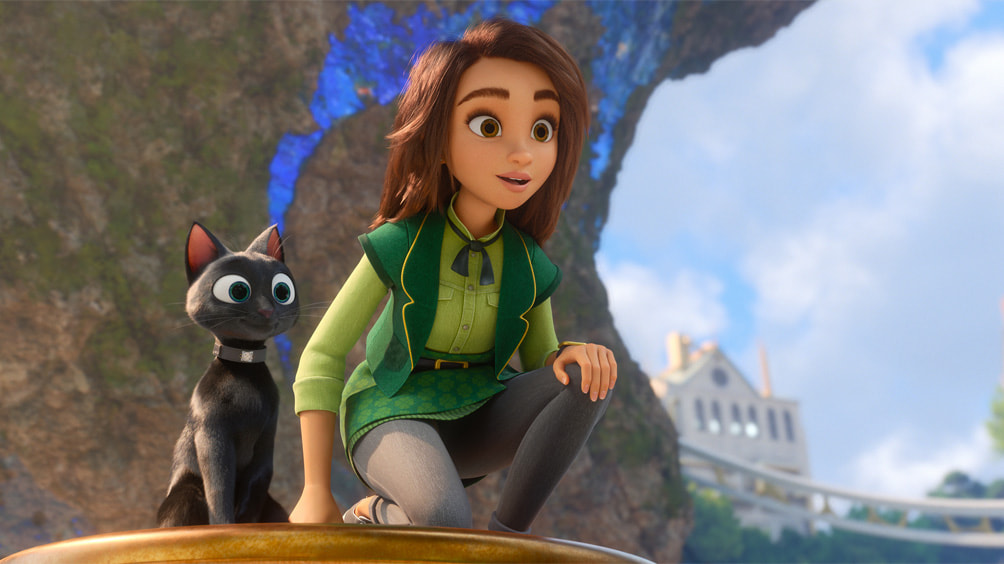
Synopsis : From Apple Original Films and Skydance Animation comes the story of Sam Greenfield, the unluckiest person in the world! Suddenly finding herself in the never-before-seen Land of Luck, she must unite with the magical creatures there to turn her luck around.
Rating: G / Genre: Comedy / Original Language: English
Director: Peggy Holmes /Producer:David Eisenmann, David Ellison, Dan Goldberg, John Lasseter, Jonathan Aibel, Glenn Berger / Writer:Keil Murray
Release Date (Streaming): Aug 5, 2022

Exclusive Interview with Director Peggy Holmes
Q: Where did this amazing story come from, and why did you want to put it out to the world?
PH: This story came from this idea we had that Sam was someone who was in the foster care system. I have a massive family. I love my family, it’s the most important thing. So I really saw a great potential in this idea of Sam as someone with no family and finding her forever family. And that forever family can look many, many, many different ways.
So I was really drawn to being able to tell a story where that could happen. Because I really feel like everyone wants to belong, right? Everyone wants to belong and I believe everyone can. It just might look different for different people.
So there was that element.
And then in the original materials, when I first looked at this movie, there was also a leprechaun — and I was like, “Wait a minute.” What if we take that idea of a leprechaun and create a whole magical world? That humans didn’t know existed. Because what we think is super-fun about the idea of luck is that humans, all of us, experience good and bad luck every day of our lives. We can totally relate to it, right?
So we wanted to have it be something relatable, but give us something we didn’t know. Which is, there’s a whole world out there that we didn’t know about that’s creating this luck that we get every day. So that’s really where it came from. Those two ideas: having a deep emotional core for the story, but setting it in a magical world so that it could just be fun and something you’ve never seen before.
Q: I love the character of Bob [Simon Pegg]. I am a cat person. His shiny coat, his sparkling eyes, his movement, everything. Can you talk about creating that lovely character?
PH: Yes. We have this amazing story artist that works for Skydance Animation named Louie del Carmen — an incredible story artist. Basically, we knew we wanted this black cat. We had done research about lucky icons, good and bad luck, international lucky icons all over the world. So we discovered that in Scotland, black cats were lucky. We thought oh, this is a fantastic thing for us because Sam, being the unluckiest girl in the world, sees a black cat and she just assumes that that black cat has bad luck just like her. We loved this idea of then flipping that, for the audience and for Sam — for Sam to find out, “Wait! You’re lucky??”
So that’s really how it came about. You do your research and you figure these things out and you think, “Okay, how can I use that in the story? How can I use that in the most entertaining way?” So we really, really fell in love with this idea that we assume he’s a bad-luck cat and we find out he’s actually a good luck cat. And then, we find out he can talk!
We gave all of that information to Louie del Carmen, so he was the first one to start to do the storyboards for that character Bob, in the moment where Sam and Bob meet for the first time. So for him, because we knew the cat wasn’t going to talk, it was all about those big eyes. We needed Sam to fall in love with him, and we needed to read his expression through his eyes. Because as you mentioned, with the black fur and the black cat, really his eyes have to tell us the story. So Louie started drawing those drawings of that cat with those big eyes, and we fell in love with it.
That was how it all began with our character Bob. And then, of course, we’re so lucky to have Simon Pegg, right? Simon Pegg is an incredible actor, so we really lucked out by getting him to do this.

Q: Besides Simon Pegg, you had Jane Fonda and Whoopi Goldberg involved in the film, can you share something interesting about working with those actors in the studio?
PH: Yes. We had to make this movie over Zoom, so we were recording over Zoom and sometimes people were recording from their homes. So that was one thing that was unique about this movie.
But also, I can tell you one thing about each of them. I could go on and on, but I’ll give you one for each. Jane Fonda, incredible actress — five thousand percent invested. She’s very curious at heart, she wants to understand how everything works.
We had a session with Jane where the story artists were actually pitching the sequences to her and showing her the storyboards before we’d even animated. You could see Jane as she’s watching the storyboards, and seeing this forty-foot dragon in all these poses. Jane started to take that into her body immediately. She was so drawn into these poses. And then she had this amazing idea. She was like, “Wait a minute. I have this massive tail. I should throw it around myself like a boa.” And we were like, “That is an amazing idea!” So we put that idea in the movie.
The other idea that Jane came up with — which was incredible — is the first time Jane meets Sam. We wanted Sam to be in awe of the Dragon. She would ooze good luck, the thing Sam has never had before in her life. Jane was like, “This is what we should do. The Dragon should exit in the elevator, come back up, see Sam, give her a wink, and go back down. Like an amazing rock star.”
So those are two — two — ideas that Jane put in the movie that were incredible. Along with her amazing performance. She is an incredible actor, she’s an incredible comedian, incredible at comedic timing.
Simon Pegg is really incredible. He comes in, he has a ton of energy. It feels like there’s a little racehorse waiting to get out of the gate. So Simon does the script, we record it three or four times for that particular scene. And then he says, “Alright. What else can we do? How can we change it? What if we try this? What if we try that?”
Because as you all know, Simon Pegg is an incredible writer. So he would work very closely with Kiel Murray, recording the scene in the way she wrote it — which was awesome, the scene was awesome. But then, he’d go “What else can we do? How can we make it funny? Maybe we could turn the joke around.” So he was an incredible, incredible collaborator with the character of Bob and with the relationship of Sam and Bob. Amazing.
Whoopi Goldberg?! When you are recording Whoopi Goldberg, it is like you are watching a master class in comedy. Whoopi would take the scene and we would record the scene. She was reading the scene and she would add all of these things — but in the context of the scene. She’s still a leprechaun, she’s dealing with the cats and the lucky pennies and the comings and the goings. But she would add all these little ad libs of someone that walked into her office, and some cat that wasn’t going fast enough. She’d add all these super-fun, crazy things, and the scene would get super-long. Then she’d go like this: [gestures] “Okay. Now let’s do it like an adult.”
And she would take the best of all those funny moments she improvised and put them in the scene and do it straightforward with two or three little added bits. And it was incredible. It was so fun to work with her, and it was so fascinating to watch how she unleashes her creativity, and then rains it in and gives you an amazing performance.
Q: Over the last two years, we’ve seen so much animation go direct to streaming. I grew up watching these films on the big screen. “Beauty and the Beast”, “Sleeping Beauty” — they were landmark moments in my life as a child. Where do you see the future of animation? Is this like a blip because it’s the pandemic, or do you see things going back to the big screen, in a year or two?
PH: I definitely see things going back to the big screen, but I think it’s something that you touched on, which is, “What’s the point?” The point is reaching as many people as possible. That’s the whole point, right? You tell stories that people can relate to that can actually have an effect on their lives — and a positive effect.
In our case, we have a very positive story, and we want as many people as possible to see it. And we’re super-excited about our partners with Apple TV. We are so excited to be sharing our movie through that platform. We’re so completely stoked.
I personally think there’s room for everything. I think there’s room for things to be streamed, I think there’s room for things to be theatrical, and people are doing mixes of both. I think it’s all about being able to put stories out in the world that will touch people in one way or another.

Q: Could you talk about the creation of the world of luck?
PH: Yeah, for sure. One of the things we wanted to do is — we’re talking about something so universal and relatable, which is good and bad luck. We all experience good luck and bad luck every day of our lives.
There are so many papers, books, lectures and college lectures about the idea of luck. Humans are kind of obsessed with it. In doing that research, we realized [that] luck is random. You can’t control it, you can’t create it. So you start with that, and then you go “Okay, now we have to create a world in which that luck would come from” — but again, it still has to be random.
The first thing I did was talk to our production designer, Fred Warter. I said “Okay, here’s the research, here’s what we need. We need to be able to create good luck, we need to be able to create bad luck.” So he went away and he came back, and the very first piece of art work he did for the movie was two worlds sitting on opposite ends of a coin. It was like a globe, an earth shape, which we recognize, or a planet shape. And then it was good luck on the top, bad luck on the bottom, and they were both on the opposite sides of the coin. And we went, “That’s it. That’s literally the world we have to create.”
And then you just start to think, what does the story need? Oh, the story needs this amazing good-luck place where nothing ever goes wrong. So all of a sudden, you go wait a minute — if nothing goes wrong, you don’t need railings. You don’t need guardrails, no one ever falls. And then you do the opposite of that, like oh, everything’s always broken! There’s scaffold, there’s duct tape. You just start to think about, what is the story telling? And what does the world need to be in order for us to tell that story?
And by the way, we’d want to be super-beautiful, in a place that you would want to go visit.
Q: In Asia the dragon usually represents good luck, good fortune. But in the Western world the dragon always means evil. In the end of “Sleeping Beauty” there was a dragon but it was pure evil. So why do you choose the dragon to be the representation of good luck in this movie? It would not make sense to people living in the Western world.
PH: Yeah, that’s what we wanted to do in the film. We did a lot of research on lucky icons and symbols from all around the world. We wanted this movie to be relatable to a lot of people. So we wanted to choose things that were lucky in one place but not necessarily lucky in another — like Bob the black cat. Black cats are lucky in Scotland, so that was a fantastic find.
We thought having the lucky dragon was amazing. Why not do that? Why not tell people about something that maybe they didn’t know? So to have the Dragon, the biggest character in the movie, and to have her represent good luck, and have her have this amazing moment in the story where she looks at bad luck in a different way — that big, massive, and powerful character has a change of heart about how she looks at bad luck — we thought was very meaningful. It was even more powerful for us, coming from a dragon that can breathe fire.
When I was making the movie, at one point I went to Madrid and one morning I was walking to get my coffee before I had to go to work. And there was a little lucky penny on the ground in Madrid. I will say, I picked that lucky penny up and put it in my pocket – for sure.
Q: In animation, the story keeps changing and there is always shifting. When you came in, how much was already there? Was the core theme, the beautiful message already there?
PH: No, that’s something that we created. The only two things that were there when I was asked to look at the movie was this idea of Sam, who was in the foster care system, and there was a leprechaun. Those were the two things.
Those were the two things that I responded to, but then took them and we created a whole original movie. Kiel Murray, the story team, John Lasseter, David Ellison, myself — we wanted to create a world we had never seen before.
I personally wanted to tell a story where someone goes from being alone to finding their forever-family. That was something that was really important to
 me.
me.
Q: How did it feel for you that these people trusted in your work and your vision? And this is the first animation for Apple. So what does it represent for you?
PH: That’s such a sweet, nice question. It’s such an honor any time anyone wants to work on something together. It’s super-hard for artists to come together and get on the same page and have a vision. And have everyone hold hands and say “Okay, let’s make it the best we can make it. Let’s do the best we can.”
I think that I definitely feel the responsibility to tell a story that’s meaningful because, as I said, the actors came on because they really believed in the story. They really loved the idea of putting a positive story out there — a story about finding your forever family, and a story about looking back at your life and realizing [that] sometimes bad luck led to a great thing. So that gives you a lot of hope.
I think it’s a great honor. It was a great honor to work with these great actors. It was a great honor to work with John Lasseter and David Ellison and Dana Goldberg. And, as you said, this is Skydance Animation’s first animated feature film, along with Apple TV’s first original feature film, and we did it together.
We all did it together. Apple saw the reels and weighed in and gave us great notes. John Lasseter, David Ellison and Dana Goldberg gave us amazing notes on the story. The actors gave us great notes as they were working on their scenes. So if you are open, open-minded, open-hearted, an open artist, we really believe — and I’ve lived through it — the best ideas rise to the top.
So if you are super-open-minded and you let everyone speak their truth about how they reacted to something, great things come from that. I am definitely honored to have directed this film. I could get choked up: people are responding so positively to it.
It’s really so awesome to hear that people are touched by the movie, and are entertained by it. Those are the two things we wanted to do.
Q: What did you want this movie to bring to your audience the most?
PH: What I would want to bring to the audience — and I hope the movie does this — is to feel inspired, and to never give up. Never give up on yourself, never give up on your dreams, never give up on finding a family. Just really keep going.
Life can get hard sometimes, and just keep going, and it will turn around. Life will turn around. That would be my lucky penny: is that people walk out feeling totally entertained and inspired and hopeful.
Check out more of Nobuhiro’s articles.
Here’s the trailer of the film.

